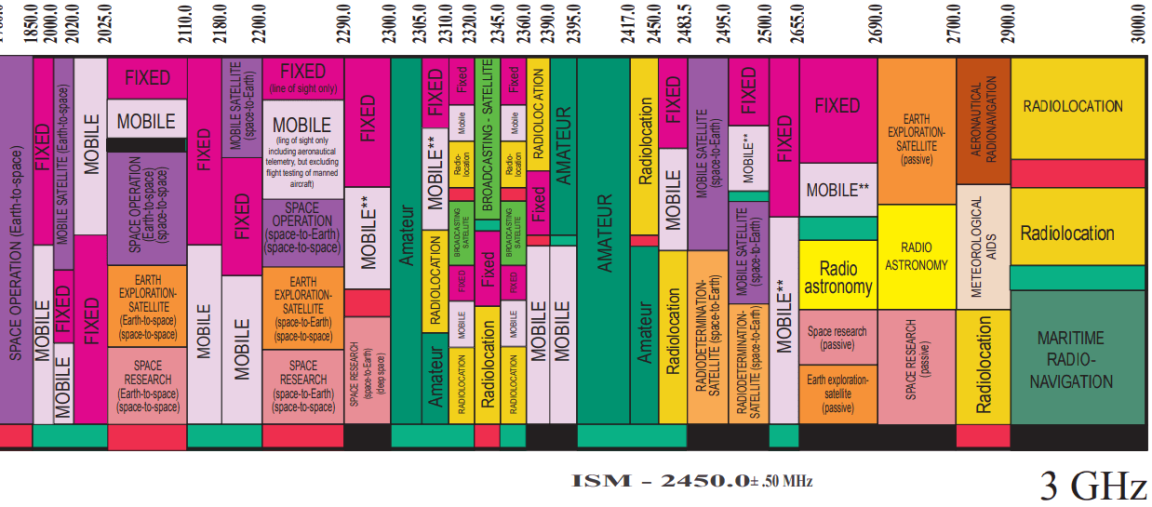FCC Spectrum Auctions Explained
With the next mid-band spectrum auction (Auction 110) kicking off on October 5, 2021, we wanted to provide a quick primer on what FCC Spectrum Auctions.

Nov 16, 2021
SHARE
Header image source: Gizbot
With the next mid-band spectrum auction (Auction 110) kicking off on October 5, 2021, we wanted to provide a quick primer on what FCC Spectrum Auctions are, why they exist, and the impact they are having on the illusive 5G rollout.
What are Spectrum Auctions?
In an effort towards creating a market-based cellular ecosystem, the Federal Communications Commission (FCC) is auctioning away slices of the electromagnetic spectrum to the highest bidder. With the goal of scooping up as much of the scarce resource as possible, mobile network operators (MNOs)—think Verizon, AT&T, and T-Mobile—are purchasing licensed radio bands (aka “spectrum”) for commercial use.
This market-based approach to spectrum management is an example of the privatization of public resources. This strategy allows governments to allocate scarce and finite spectrum that enriches their coffers while winning bidders put their acquired resources to highest-value use.
However, some scholars have criticized spectrum auctions. In 2015, economist Jeffrey Eisenach of the right-leaning American Enterprise Institute (AEI) stated: "hile auctions are inherently economic, not political, exercises, regulators and politicians can still exercise favoritism through the rules that govern how the auctions work. By imposing “set asides,” “bidding credits,” “spectrum caps,” and similar provisions, officials can tip the scales in favor of politically popular interest groups. Such favoritism is usually defended by arguing that government should subsidize new entry into mobile wireless markets, which would otherwise be insufficiently competitive."
The FCC began competitive auctions of radio spectrum in 1994. Since July of that year, the FCC has conducted over 100 auctions, raising tens of trillions of dollars for the U.S. Department of the Treasury.
Why Do the Auctions Exist?
Congress enacted the Omnibus Budget Reconciliation Act in 1993, authorizing the FCC to hold competitive auctions from among "two or more exclusive applications for an initial license."
Contrary to skeptics like Eisenach (who, not coincidentally, is also an opponent of net neutrality), “The FCC has found that spectrum auctions more effectively assign licenses than either comparative hearings or lotteries. The auction approach is intended to award the licenses to those who will use them most effectively. Additionally, by using auctions, the (FCC) has reduced the average time from initial application to license grant to less than one year and the public is now receiving the direct financial benefit from the award of licenses.”
Who Participates?
Participants in FCC spectrum auctions vary depending upon the radio bands offered. The electromagnetic spectrum ranges between frequencies less than 1 hertz (Hz) to those exceeding 10^25 Hz.
Some frequencies have military and industrial applications. Since ELF and SLF bands penetrate seawater, the U.S. Navy uses these frequencies to communicate with submerged submarines. Miners employ ULF bands since they penetrate rock. More commercial uses of radio spectra vary between LF (AM radio) to SHF wavelengths. One SHF application is 802.11a/n/ac/ax WiFi, which uses the 5 GHz frequency band. Note that the full range of WiFi 5 GHz frequencies range from 5.15 GHz to 5.85 GHz, while WiFi 6 uses spectrum between 1 GHz to 6 GHz.
Governments rigorously regulate the use of radio spectrum in concert with the International Telecommunications Union (ITU), which allots spectrum to various players based on usage.
Hundreds of entities have submitted winning bids for licensed spectrum in FCC auctions since 1993 (before 1993, the FCC allocated spectrum by lottery.) They include MNOs, telephone cooperatives, television stations, paging companies, private equity firms, inventors/patent holders, real estate firms, trust funds, physicians, and many others.
How Do the Bidding Rules Work?
The "Auction Designs" are Simultaneous Multiple-Round, i.e., "all licenses are available for bidding throughout the entire auction." The FCC explains: “Unlike most auctions in which bidding is continuous, SMR auctions have discrete, successive rounds, with the length of each round announced in advance by the Commission... After each round closes, round results are processed and made public. Only then do bidders learn about the bids placed by other bidders. This provides information about the value of the licenses to all bidders and increases the likelihood that the licenses will be assigned to the bidders who value them the most... In an SMR auction, there is no preset number of rounds. Bidding continues, round after round, until a round occurs in which all bidder activity ceases. That round becomes the closing round of the auction.”
In addition, the auction design can be altered to "allow combinatorial or 'package' bidding. With package bidding, bidders may place bids on groups of licenses as well as on individual licenses." These procedures "allow the auction to proceed at an appropriate pace, to encourage straightforward bidding, and to permit bidders to employ flexible backup strategies."
Most Recent Auction and Results
Auction 107 or the "C-band auction,” running from December 8, 2020 to February 17, 2021, sold flexible-use licenses in the 3.7-3.98 GHz range of spectrum. Winning bids totaled over $81 billion and 21 bidders won all of the available 5,684 licenses. See this for a complete list of winning bidders, their bids, and licenses won.
Auction 107 was described as a "once in a lifetime event," as it sold licenses for "beachfront" (midband) spectrum to be used for 5G. The auction fetched billions more than analysts expected.
What to Expect from the Next FCC Auction - Auction 110
Auction 110, scheduled to start on October 5, 2021, will sell 4,060 licenses for partial economic areas (PEAs). Licenses will be auctioned in 10 blocks with each block containing 10 MHz of 3.45 — 3.55 GHz spectrum (known as the 3.45 GHz band). No bidder can win more than four blocks, a rule meant to protect MNOs from bloodying each other in bidding wars. Typically, multiple counties comprise a single PEA.
Rules stipulate that the auction will be carried out in two phases. First, bidders will vie for "generic spectrum blocks." In the assignment phase, first phase winners will tender bids for specific blocks within the band.
Like the previous C-band auction, the 3.45 GHz band is also considered to be beachfront spectrum, prized for its capability to transmit prodigious amounts of data across considerable distances. Expect vigorous bidding, particularly from winners in the previous auction since the bands now on the block are adjacent to those previously auctioned off. By combining bands, MNOs boost network capacity and speeds.
The latest buzz is that T-Mobile and Dish will be coming in hot to Auction 110, while Verizon might be taking a back seat.
How FCC Auctions Impact Wireless
These recent FCC auctions are intended to repurpose "Goldilocks" (midband) spectrum previously used by satellite operators to MNOs for 5G use.
In recent years, MNOs have decommissioned their 2G and 3G networks as they redirect spectrum for LTE use. But as mobile usage continues to skyrocket, more spectrum is needed to meet consumers' demands for both data speed and capacity.
U.S. Frequency Allocations Between 1.85 GHz to 3 GHz in 2016

Source: U.S. Department of Commerce/Wikipedia
Usable radio spectrum is a scarce and valuable commodity. Expect to see more demands from both MNOs and consumers for the FCC to repurpose mid-band spectrum for LTE and 5G use.
Thirsty for more? Check out our blog on 5G as an enterprise internet redundancy option.
Want to learn more about how Lightyear can help you?
Let us show you the product and discuss specifics on how it might be helpful.
Not ready to buy?
Stay up to date on our product, straight to your inbox every month.
